HAMPI (Vijayanagar), India
This area has recently received quite a bit of press and visits from several top geezas. Our man Dave Ferguson visited whilst on his travels in 1998. Basically it sounds like there's shed loads of bouldering and an essential tick on the "culture front". Here's what he's got to say:
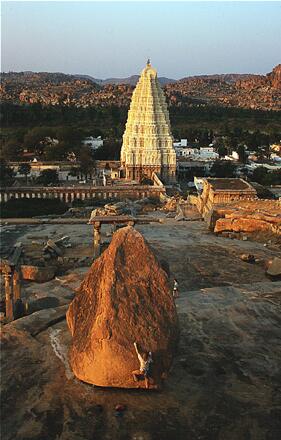
Jane Weir on one of the world's most photogenic boulders, Hemakuta Hill.
In 1336 the Telugu princes Harihara and Bukka decided to found a magnificent empire in southern India. Being powerful boulderers they built their capital at Vijayanagar (also known as Hampi, the central village of the site) in a landscape covered by rounded granite boulders, giving themselves lots of building material and copious cranking possibilities.
In 1565 the empire came to a sudden and bloody end with defeat by the northern Muslim armies, who spent more of their time training to kill, than to deadpoint. After a 6 month siege the city was ransacked and the glory days were over.
We have a lot to thank these northern sultans for, as had they not bashed the city then it would undoubtedly have turned into a typical sprawling Indian mess of assorted concrete shacks and mounds of rubbish. In fact the little bazaar town of modern-day Hampi is quite pleasant, your eye is drawn away from the modern architectural horror-shows by the magnificent Virupaksha temple. The usual motley collection of cows, beggars and 3-legged dogs are scattered around the place, and the aromas can get a little ripe at times, but they're easily escapable.
The Hampi site can be divided into two main areas: the Sacred Centre and the Royal Centre, the former spreading eastwards from the main bazaar while the latter is 2km to the south. The Royal Centre differs from the Sacred Centre in that it is generally lot flatter and not so well endowed in the rock department, though it is decorated nicely with banana plantations.
From Hampi, the entire visible landscape is covered with boulders or crags, the task of exploration is mind boggling. The best thing to do is get out and tramp around. Hiring a bicycle or moped can help exploration of some of the further points, but as soon as you arrive it will become clear that there is no shortage of rocks within walking distance.
Hemakuta Hill
This is an easy first stop, being only 2 minutes walk from Hampi Bazaar. On a big shield of bare rock overlooking Virupaksha temple are deposited many pleasantly featured boulders. Most of these are climbable, mainly slabs and walls with a few steeper problems up slightly creaky flakes. This is a fantastic place to come and watch the sunset, a fact not lost on the postcard/tea/cake vendors.
A word of warning: the
boulders nearer the top of the hill are nicely secluded which has resulted
in them being popular toilet spots, so watch where you land.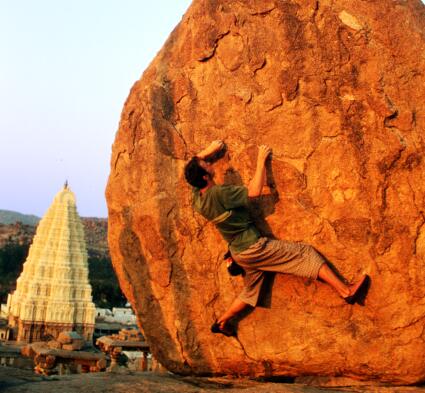
The author, a crimpy V4 and a Hampi sunset, Hemakuta Hill
Take the track left in front of the main entrance to the Virupaksha temple, and turn right through the gate in the old wall. A 2 minute walk.
Matanga Hill
A slightly longer hike form Hampi Bazaar rewards you with the best views of the area. The bouldering potentials are not as great, though there are several worthwhile problems on the NW side of the summit including an obvious burly traverse. The precipitous landings to some of the more thoughtlessly located boulders are more than compensated for by the tremendous views.
The best approach is up the steepest path form the Eastern end of Hampi Bazaar. A 20 minute walk.
Tiruvengalantha Temple
On the left-hand side as you approach this temple are a few varied boulders. Nothing to write home about, but as its only a short walk form Hampi Bazaar its a nice early morning venue. The cows nearby are pretty sloppy spotters.
Just follow the main track sign-posted to the Vittala temple, and turn right at the appropriate sign. A 10 minute walk.
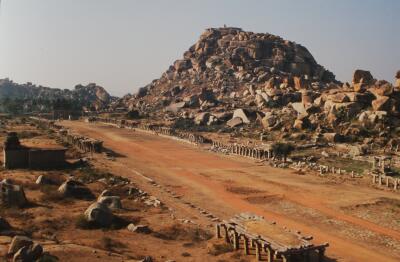
The approach to Tiruvenga Temple
Malyavanta Raghunatha Temple
This is only really an option if you have some form of transport as its about 8km from Hampi Bazaar, which is a shame because its by far the best venue we found. The temple itself is quite beautiful and is still frequently used for ceremonies. It is rarely visited by foreigners as its so far away, so the locals seem very interested in whatever you're up to.
If you go through the front doors of the complex and out the back ones you will discover loads of brilliant free standing boulders. It's a lot more varied than Hemakuta Hill, with more steep stuff plus cracks and aretes. Being away from the crowds it's an idyllic place to while away the evening, watching the sun set over the ruins. Its also a nice place to watch groups of children poohing on the hill, if that's your cup of tea.
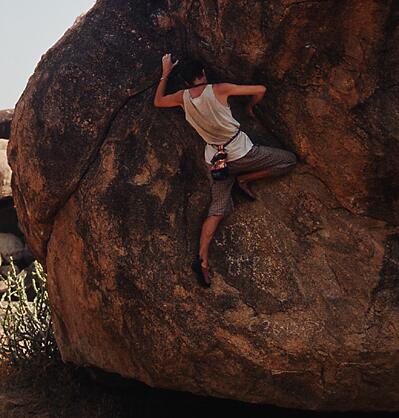
A grubby-vested Dave Fergusson
There are many more possibilities for exploration, for instance in the hills west of Anagondi, over the river. It's possible to cross the river at several places by man-powered coracle. The trip will set you back 3 or 4 rupees.
We found that as a rule the best spots were on hills where the ground was bare rock and the boulders deposited on top. It is well worth getting a bike of some sort as there are good roads around the edge of the site and reccees in form there are easy.
Timing is very important as only early morning or sunset is cool enough, the rest of the day is best spent in a cafe or cave.
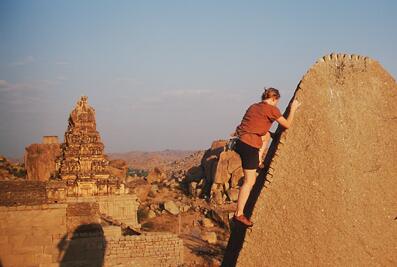
Jane Weir (and shadow) over Malyavanta Raghumatha
Routes
There are a few bolt protected routes scattered around the site, though the potential for more is staggering. However I don't think the Archaeological Survey of India would react favourably to wholesale bolting in what is also a popular Hindu pilgrimage centre.
At Hemakuta Hill there are 2 poorly protected routes up the largest free-standing boulders (for beta watch the monkeys).
If you walk around the south side of Virupaksha temple and along the dirt road for about 200 metres, you will discover a collection of huge boulders leaning nonchalantly on each other. There are 5 good looking and well bolted routes up the biggest of these.
About 2km along the road to Kamalapuram are two enormous boulders forming an arch on a hill. There are 2 well bolted and one slightly thinner one on the different faces.
None of the grades for these routes are known, and there may be more. Although its easy to justify carrying shoes and chalk across India to boulder here, the hassle of lugging ropes et al to climb routes just isn't worth it.
Despite the difficulties in getting to Hampi, it is sure to become a world-favourite bouldering venue. It offers so much more than other areas: the combination of pristine granite, gnarly monkeys, magnificent temples and beautiful sunsets creates a truly spiritual cranking experience.
The Score
It would be justifiable to visit Hampi for even just a short holiday. It's a popular spot for travellers to head for after Goa, from where there are regular overnight buses (Rs350). Goa is about 14 hours by train or a short flight from Mumbai (née Bombay), the most popular entry point into India. Flights from London to Mumbai (Bombay) start at around £250 return (but shop around and you may get one cheaper)
The best time to visit is winter, by February its up to 30ºC and between May and November the place suffers from monsoon conditions (hot and wet).
The cost of living in India is incredibly cheap. On average a double room in a hotel will set you back Rs150, a meal for two Rs100, and 500km on the train Rs200. At the time of writing you would get around ('99) Rs70 to the £.
The nearest train station is Hospet, 15km away, where you can book train tickets to and from anywhere in the country. There are buses to Hospet every half hour.
Hotels range from your basic mattress-on-the-floor for Rs50 a night, to slightly nicer bed and attached "bathroom" for Rs150. There are also mud huts(Rs40) over the river though they're not very conveniently situated. Its best just to look around, the cheapest are down the side road from the Bazaar, the better ones near the tank.
Any number of eateries offer similar sustenance (Indian dishes plus variations upon western and Chinese themes) at similar prices. A typical south Indian Masala Dosa will set you back Rs20, but it gets a bit tedious after a while.
Cakes and Beer There are no less than 3 cake shops, which for a town with a population of 400 is a pretty good ratio. However there are no beer shops or licensed bars in Hampi, apparently the police are actively discouraging alcohol consumption in the town. This does not seem to deter many places offering it on the sly (Rs60 for a 600 ml bottle of Kingfisher). There is a beer shop in Kamalapuram, where you can buy cold ones for Rs45, along with evil local whiskies.
Bicycles can be hired for Rs20 a day from a number of places, they're definitely not dedicated hill-climbing beasts but they get you around. A ragged collection of motorcycles can be hired from near the easily visible Vikky Roof Top cafe off the main bazaar. Prices are negotiable but should be around Rs100 a day.
About the author: Dave Ferguson, is currently working in the big smoke (London). He has onsighted quite a few E5's as well as a few Grit E6's, headpointed E7 and done some tricky boulder problems, especially of the jumpy nature. He has also come up with some dodgy route names - Butt Munch, Micro Munter and Sexual Misadventures With Some Fromage Frais being the best examples. He used to climb the mud-cliffs near his East Devon coast home using his "knives" - nice! His own site is located here
POSTSCRIPT Another of our roving reporters, Ben Rowe, visited in the summer of 2000. He reports that the area is becoming increasingly bolted. Obviously, as foreigners, us Brits have no right to define the climbing ethics of the area but given its' religious importance maybe less intrusive styles of climbing would be better...how's about trying to spread the tradition of dodgy headpoints a la gritstone stylee!!??
